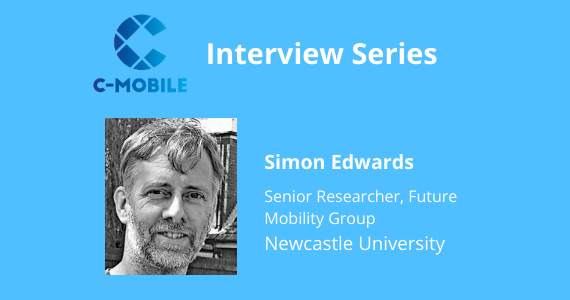Interview with Simon Edwards, Newcastle DS leader
Together with local partners, you have been involved in several EU projects focusing on C-ITS and solutions for cities (such as Compass4D), what are the priorities for a city like Newcastle in terms of improving safety, traffic management and in general mobility for road users?
The overriding priority for Newcastle, along with all UK cities, is improving air quality. Transport is obviously a key cause of pollution in urban areas but can also be a solution, hence, the city’s prioritisation of public transport modes and active travel. The COVID 19 health crisis has of course had a major impact on this, with public transport use now officially discouraged, in a U-turn of the previous 30 years of transport policy. We hope that this will be temporary but even so it may take many years for commuters to fully trust health and safety in public transport, and as a consequence there may well be another major challenge to get people back out of their cars. Newcastle is looking to avert a new transport crisis by robust promotion of cycling and walking, with major changes to the urban streetscape taking place to facilitate this.
The potential of C-ITS is still seen in the same way it was when we started work in this area in 2013. We want to use it to improve journey time reliability for selected vehicles, primarily buses, emergency vehicles and patient transfer vehicles, commercial vehicles, and taxis. This will also permit more flexible network management. C-ITS services that contribute to reduced energy use and reduced emissions, such as GLOSA, are the priority.
Do you have any success stories about transport solutions that the city has implemented?
For approximately 30 years, the city has been discouraging private car use, at least in the centre, whilst promoting alternative modes. Cities in the UK are a little constrained in how they can do this because the fragmented private ownership of ‘public’ transport compromises the ability to exert full operational control. Also, recovering from a decade of ‘austerity’ politics the city has struggled with financial pressures, with central government requirements to focus stringently on air quality whilst also restricting local authorities means of raising money through local taxation. However, the City has always placed itself in a position to engage in research and innovation and has a close relationship with Newcastle University. Consequently, its work with C-ITS, electro-mobility, mobility as a service, connected and autonomous mobility, and accelerated enhancement of pedestrian and cycling environments mean that it is most definitely heading in the right direction. The big future challenge will be ensuring mass use of public transport again in the future – a crucial component to help deliver wider economic, social and environmental goals.
You are the UK deployment site leader, what do you hope to achieve with this project but also for the city in general?
I would like to see all the planned C-ITS corridors up and running reliably and sustainably with many beneficiaries/ users. We believe that longer term the use of cellular services will be most efficient to deliver C-ITS services from both a technical and user-friendly point of view, but we need to be careful that this does not dilute the policy objectives of the local authority by facilitating private motorists to take advantage of these services merely by downloading a publicly available App.
In addition to its own benefits, I also personally see C-ITS as a ‘stepping-stone’ towards autonomous or semi-autonomous operations for some modes of transport and some users who would specifically benefit e.g. tightly scheduled freight operations, mobility services for older and disabled people. This is an exciting area in which both the City and UNEW are interested.
What is the most exciting and innovative aspect of C-MobILE for you, App/services deployed?
The cellular services, which were not planned originally but have been introduced in a relatively short space of time. This has involved excellent working relationship between UNEW, NCC, Siemens, Zircon, and NeoGLS. The services could eventually be large scale by being accessible to anyone, although that might well be contrary to the policy objectives of the city.
We are very interested also in the outcomes from the project at other sites relating to C-ITS for pedestrians and cyclists, as this is likely to be something we build on in the post-COVID era. Copenhagen’s results could be very interesting.
A final exciting and unanticipated outcome has been the collaboratory working relationship involving Siemens, Zircon, and NeoGLS and partners in the Interoperability Task Force.
Why the participation in such projects is important for research institutions? What are the main benefits in working with an international consortium of public and private partners?
See previous response about collaboration. The breadth of learning, and the experiences that we can benefit from and also provide to our large network of international partners across multiple sectors, both public and private, would not be achievable in a UK-only environment. It avoids national ‘silo’ development and increases harmonisation and standardisation whilst still permitting locally specific research and development and implementations. Like many people in the UK, I am still very much in favour of European collaboration!
Tell us more about your experience and research in the field before embarking on the C-MobILE project.
Although I have worked in ITS since 2001, I became involved in C-ITS with the Compass4D project and have since read around the subject a lot, as it also contributes to university teaching. I had some practical experience of the Newcastle deployment in C4D, and also led the team that performed the overall evaluation for all the sites in that project. More recently I have been involved in CAPITAL, which developed a set of training modules. Both were exemplar C-ITS projects, in my view. This has given me a good background in all aspects of C-ITS. As a research group we are also now moving heavily into connected and autonomous mobility, which we see as a logical next step.
————————————————-
About Simon Edwards
I am a Senior Researcher in the Future Mobility Group at Newcastle University, UK, with extensive experience in all aspects of Intelligent Transport Systems (ITS). Since 2001 I have been involved in much of our Europe-facing research, and have participated in many successful applications for European research funding whilst developing a network of research contacts across the continent, and an excellent working relationship with our key ITS collaborators. I am experienced and knowledgeable in many different areas of ITS, including currently cooperative ITS, urban mobility and electro-mobility. My specialist field is Inclusive Mobility, meaning accessibility for disabled and older people, an area in which we have international recognition. I am also very experienced in user evaluation processes and assessment of the practical application and acceptance of ITS.
About the University of Newcastle and the other partners involved in the DS
Newcastle University is a leading centre of transport technology in Europe, with the Future Mobility Group contributing a significant research role in the development of: connected and autonomous vehicles; air quality and decarbonisation; electromobility; connected infrastructure for smart cities and smart transport for ageing and mobility. The team works closely with world leading industry including Nissan, Siemens and Hitachi as well with many SMEs and the wider supply chain through partnerships with the North East Automotive Alliance; ITS UK; the Connected Places Catapult; NICA (National Innovation Centre for Ageing) and NICD (National Innovation Centre for Data); and through key networks, such as ERTICO, ECTRI, POLIS, UKCRIC, the Centre for Energy System Integration (CESI) and the Energy Research Partnership. Currently FMG has EU funded projects including Mobility as a Service and eHUBS that are generating new knowledge in terms of data, models and tools, which is transferrable to the NE Region; access to data from one of the largest charging networks in Europe for electric vehicles, integrated data collection facilities developed with industry capturing and processing urban data in real-time; vehicle and systems data from C-ITS projects including C-MOBILE (EC, 2017-20) , C-ITS Evaluation (DfT, 2018-19), C-ITS Smart Corridor Newcastle (DfT 2015-2019), and COMPASS4D (EC, 2013-2016); integration of the regional traffic management and control centre hosted at the University as a research tool; innovative and ultralow emissions logistics trials using remote sensing coupled with simultaneous real-time air quality, noise and meteorological conditions monitoring through the Urban Observatory.
Other local partners in C-MOBILE:
• Newcastle City Council – key deployment partner supporting underlying transport and C-ITS policy and stakeholder engagement
• Siemens UK -long time technical supplier at Newcastle City Council, and sub-contractor to C-MOBILE as systems integrator
• Zircon- contractor to Newcastle City Council to supply ITS-G5 HMI/App for Arriva buses
• NeoGLS- C-MOBILE partner delivering Bordeaux App for cellular services in Newcastle
• Arriva- part of DB group, the operator of Express bus services from Newcastle to south Northumberland towns like Ashington. A key stakeholder beneficiary in C-ITS
• North East Ambulance Service – operator of emergency and patient transfer vehicles in the region, and a key stakeholder beneficiary in both Compass4D and C-MOBILE


